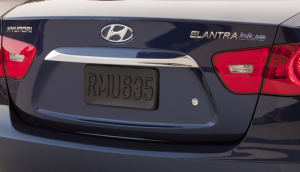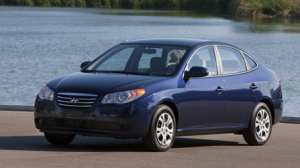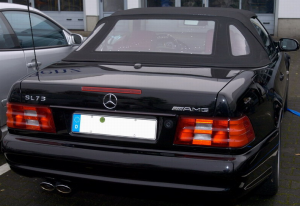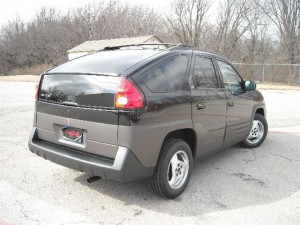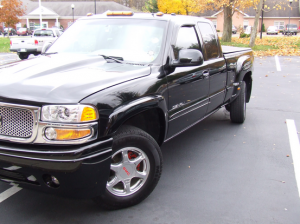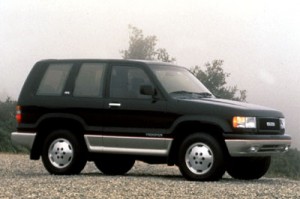Hyundai Elantra Blue: It Exists
Posted by Doug DeMuro in It Exists on | 11 comments
I recently discovered something unusual: a rare Korean car.
I write a lot about rare cars here, but almost never about rare Korean cars. That’s because the Koreans don’t tend to build rare cars. Instead, they build volume cars in huge numbers and hardly pause to think things like: What if we did a convertible pickup? It’s for this reason, I believe, that car enthusiasts have generally not latched on to Korean cars.
But today I bring you one Korean car that is unusual: the Elantra Blue.
Now, I know what you’re thinking. You’ve looked at the photo and you’re thinking: That’s just a normal Elantra! And you are, for the most part, completely correct. But the Elantra Blue is rare, entirely because it was Blue.
So you might be wondering exactly why a paint job makes a car rare. Well, it isn’t the paint job. It turns out that Hyundai once offered a trim level called “Elantra Blue.” In fact, it even showed up on the trunklid in order to prove its specialness:
The Elantra Blue was a special high-efficiency version of the standard Elantra with a stick shift and improved, efficiency-minded gear ratios. And here’s the coolest part: it was only available for the 2010 model year.
A one-year-only, ultra-rare Hyundai trim level? The Elantra Blue is sort of an automotive unicorn. And if you ever see one on the road, now you know.
Mercedes SL73 AMG: It Exists
Posted by Doug DeMuro in It Exists on | 12 comments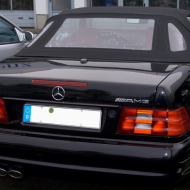
Most of us know about the Pagani Zonda. For those of you who don’t know about it, a brief overview: imagine the meanest looking supercar you can conceptualize. Now, double it. And place four exhaust pipes where a normal car might have the license plate. That is the Pagani Zonda.
Most people also know the Pagani Zonda used an AMG engine. For those of you who once again don’t know this, a brief overview: the Pagani Zonda used an AMG engine. It was a 7.3-liter V12 that made some monstrous amount of power and torque that print magazines probably used exclamation points to describe.
Admittedly, the Zonda also used a few other engines, but the 7.3 was the pinnacle. Now, here’s something you don’t know: this engine was also available in an SL-Class.
Yes, that’s right: the mid-1990s Mercedes SL73 AMG actually existed. It’s the largest engine ever to go into an SL-Class (and probably any roadgoing Mercedes), though, admittedly it wasn’t the most powerful. Still: 525 horses is nothing to scoff at. Apparently, the later SL70 AMG also shared its powerplant with 7.0-liter versions of the Zonda.
Unfortunately, Mercedes never sold the SL73 AMG here, almost undoubtedly because warranty costs would’ve bankrupted them. But somewhere in Europe, some old guy who went into the Mercedes dealer and said he wanted the “top of the line SL-Class” is driving a luxury convertible with the same engine as the Pagani Zonda. How cool is that?
First-Ever Pontiac Aztek: It Exists (On Ebay!)
Posted by Doug DeMuro in It Exists on | 8 comments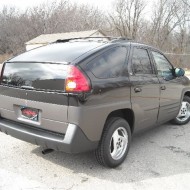
I’m thinking about buying this. Or, I should say, I thought about buying this, back when it was three grand. Autoblog ran a story on it the other day, and I figured it wouldn’t top $5k. Well, I was wrong.
Let’s back up. What, exactly, is this? It’s a 2001 Pontiac Aztek currently on eBay with the auction price at $14,322.22. And why is it so expensive? Because it’s the first Aztek ever made.
That’s right: 2001 Pontiac Aztek VIN# 00001 is currently offered on eBay in pristine condition and – this is true – with a Barrett-Jackson license plate screwed on. It turns out this Aztek (described several times in the listing as an “Aztec”) sold for $15,950 at B-J in 2009, which is stunning when you consider it sold for $22,000 eight years early. That’s BMW Z8 depreciation.
Of course, not every Aztek saw values stay so strong. Number 00001 is one-of-a-kind; the very first example of a model that showed Pontiac no longer had to resort to rebadged versions of other GM models. Yes, this one was different. This one … had plastic cladding.
Maybe more ridiculous than the selling price, or the #00001 serial number, is the fact that the previous owners have kept it in mint condition. The odometer has less than 8,000 miles on it. The seats are perfect. The body is excellent.
Some previous owner thought this car would be worth something one day – and who knows, they might still be right. Humorously, that owner wasn’t Pontiac, who apparently let the first Aztek out of its sights. And sadly, it won’t be me. I don’t care how many zeroes are in the VIN: this is crazy money for an Aztek. It’s even crazy money for an Aztec.
GM Quadrasteer: It Exists
Posted by Doug DeMuro in It Exists on | 9 comments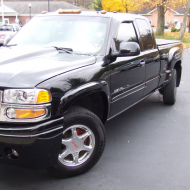
Today we’re going to talk about a subject I recently covered on The Truth About Cars. And that subject is: Quadrasteer.
For those who don’t know, Quadrasteer was a four-wheel steering option that General Motors offered on its GMC Sierra Denali pickup and – this is the cool one – the GMC Yukon XL and Chevrolet Suburban 2500. It only lasted a few years, mainly because there were only about 80 people out there who got really excited by it.
I’m one of them.
I think Quadrasteer is awesome, largely because it transformed these behemoth trucks into small cars when it came to the turning circle. But also because if you see a truck equipped with Quadrasteer in traffic, you can watch it turn and see all four wheels move! How cool is that? (Many of you are thinking: not cool at all. You are probably the same people who think fireworks are lame.)
Of course, there were actual benefits to Quadrasteer beyond cool factor. Those who tow boats and large trailers found the system to be incredibly beneficial, for example. The same is true for anyone trying to drive one of these vehicles in a large city.
Unfortunately, GM pulled the plug on Quadrasteer after three model years. Initially it was standard in the Sierra Denali, though it eventually became optional at a massive price jump. When no one bought it, GM bailed, leaving the pickups with the tightest turning circle around relegated solely to the used market.
Two-Door Isuzu Trooper: It Exists
Posted by Doug DeMuro in It Exists on | 26 comments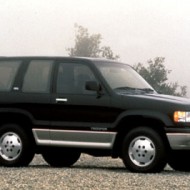
Once again, I’ve been away. This is, I swear, the very last time. It just turns out that writing a book, and then editing a book, and then formatting a book is much more difficult than I ever realized, which is why competent writers have people to do these things.
Fortunately, I’ve returned with one of my favorite “It Exists” cars to get things going again. And that car is: the two-door Isuzu Trooper.
Now, I’ve never witnessed a two-door Isuzu Trooper in person. A second-generation model, that is. We’ve all seen first-gens rotting out on the lawns of rural America. But I wish I’d seen a second-gen, because just look at this thing. It looks like a completely unconvincing Photoshop of a four-door Trooper.
In the States, we got this from 1993 to 1995. Other markets got it a little longer. And Australia got it as – this is entirely true – the Holden Jackaroo. I’d love to see the focus group results on that one.
What I like best about the two-door Trooper is that it appears virtually nothing was altered from the normal Trooper, aside from a much shorter wheelbase. So that means the car Consumer Reports rolled over as a four-door was now even smaller and less stable. This, I believe, would only amount to lots of fun.
Sadly, we’ll never know for sure. Few two-door Troopers were made, and even fewer exist. Bonus points to anyone who finds one for sale online. Even more bonus points to anyone who actually purchases one. Just go slow around the turns.
